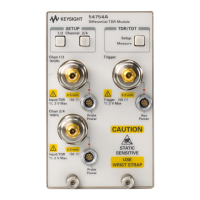Transmission Line Theory Applied to Digital Systems
Transmission Line Design
11-5
where:
v
A
(t) = voltage at point A,
x = the distance to an arbitrary point on the line,
l = the total line length,
t
pd
= the propagation delay of the line in ns/unit distance,
T
D
= l t
pd
,
u(t) = a unit step function occurring at t = 0, and
E
S
(t) = the source voltage at the sending end of the line.
When the incident voltage v
1
reaches the end of the long line, a reflected voltage
v’
1
will occur if R
L
≠ Z
o
. The reflection coefficient at the load, ρ
L
, can be obtained
by applying Ohm's Law.
The voltage at the load is v
1
+ v’
1
which must be equal to (i
1
+ i’
1
) R
L
. But i
1
= v
1
/Z
o
, and i’
1
= -v’
1
/Z
o
(the minus sign is due to v’
1
, travelling toward the
source). Therefore,
(2)
By definition
Solving for v’
1
+ v
1
in equation 2, and substituting in the relation for ρ
L
results in:
(3)
Similarly, the reflection coefficient at the source is:
v
A
t
()
E
s
t
()
Z
o
Z
o
R
o
+
------------------
=
v
1
v
′
1
+
v
1
Z
o
-----
v
′
1
Z
o
-------–
R
L
=
ρ
S
reflected voltage
incident voltage
----------------------------------------
v
′
1
v
1
-------==
ρ
L
R
L
Z
o
–
R
L
Z
o
+
------------------=

